

AlphaLISA SureFire Ultra Human and Mouse Total NFκB2 p100/p52 Detection Kit, 50,000 Assay Points
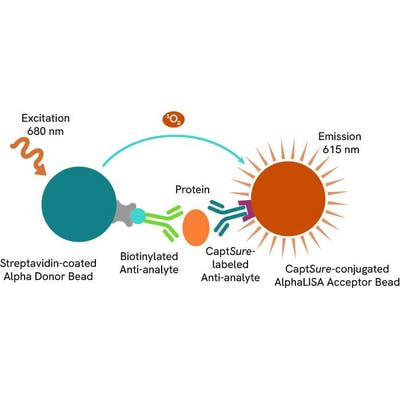
AlphaLISA SureFire Ultra Human and Mouse Total NFκB2 p100/p52 Detection Kit, 50,000 Assay Points
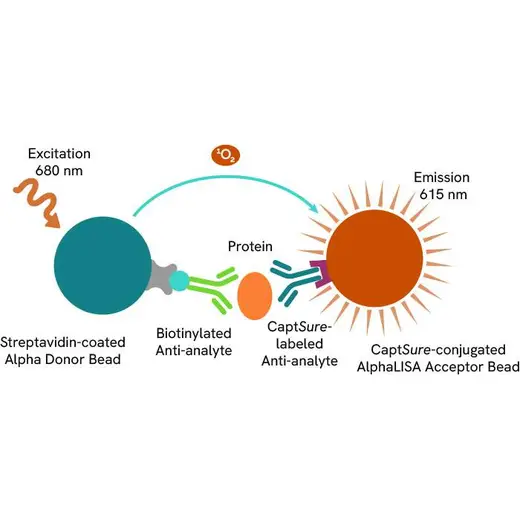

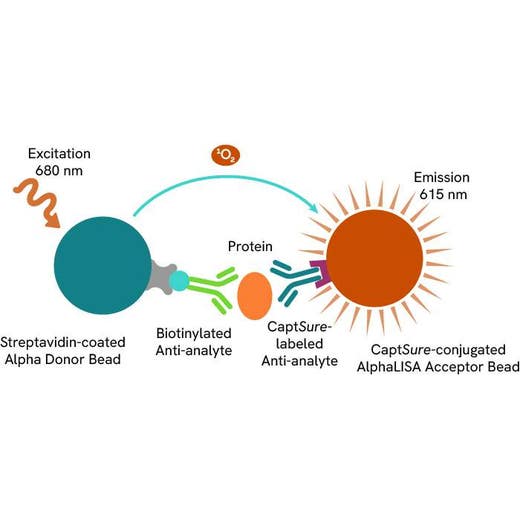

The AlphaLISA™ SureFire® Ultra™ Human and Mouse Total NFκB2 p100/p52 assay is a sandwich immunoassay for quantitative detection of total NFκB2 p100/p52 in cellular lysates using Alpha Technology.
For research use only. Not for use in diagnostic procedures. All products to be used in accordance with applicable laws and regulations including without limitation, consumption and disposal requirements under European REACH regulations (EC 1907/2006).
| Feature | Specification |
|---|---|
| Application | Protein Quantification |
The AlphaLISA™ SureFire® Ultra™ Human and Mouse Total NFκB2 p100/p52 assay is a sandwich immunoassay for quantitative detection of total NFκB2 p100/p52 in cellular lysates using Alpha Technology.
For research use only. Not for use in diagnostic procedures. All products to be used in accordance with applicable laws and regulations including without limitation, consumption and disposal requirements under European REACH regulations (EC 1907/2006).


AlphaLISA SureFire Ultra Human and Mouse Total NFκB2 p100/p52 Detection Kit, 50,000 Assay Points


AlphaLISA SureFire Ultra Human and Mouse Total NFκB2 p100/p52 Detection Kit, 50,000 Assay Points


Product information
Overview
NF-κ-B2 p100 is a precursor protein of the NF-κ-B family, which plays a key role in regulating immune response, inflammation, and cell survival. p100 can be processed to p52, a transcriptionally active form that enters the nucleus to activate target genes involved in immune response and apoptosis. Dysregulation of NF-κ-B2 is associated with inflammatory diseases, autoimmune diseases, certain lymphomas and multiple myeloma, making it a potential target for therapeutic strategies.
The AlphaLISA SureFire Ultra Human and Mouse Total NFκB p100/p52 Detection Kit is a sandwich immunoassay for the quantitative detection of total NFκB p100/p52 in cellular lysates, using Alpha Technology.
Formats:
- The HV (high volume) kit contains reagents to run 100 wells in 96-well format, using a 60 μL reaction volume.
- The 500-point kit contains enough reagents to run 500 wells in 384-well format, using a 20 μL reaction volume.
- The 10,000-point kit contains enough reagents to run 10,000 wells in 384-well format, using a 20 μL reaction volume.
- The 50,000-point kit contains enough reagents to run 50,000 wells in 384-well format, using a 20 μL reaction volume.
AlphaLISA SureFire Ultra kits are compatible with:
- Cell and tissue lysates
- Antibody modulators
- Biotherapeutic antibodies
Alpha SureFire Ultra kits can be used for:
- Cellular kinase assays
- Receptor activation studies
- Screening
Specifications
| Application |
Protein Quantification
|
|---|---|
| Automation Compatible |
Yes
|
| Brand |
AlphaLISA SureFire Ultra
|
| Detection Modality |
Alpha
|
| Host Species |
Human
Mouse
|
| Molecular Modification |
Total
|
| Product Group |
Kit
|
| Shipping Conditions |
Shipped in Blue Ice
|
| Target |
NFkB2
|
| Target Class |
Phosphoproteins
|
| Target Species |
Human
|
| Technology |
Alpha
|
| Therapeutic Area |
Inflammation
|
| Unit Size |
50,000 Assay Points
|
How it works
Total-AlphaLISA SureFire Ultra assay principle
The Total-AlphaLISA SureFire Ultra assay measures the expression level of a protein target in a cell lysate.
The Total-AlphaLISA SureFire Ultra assay uses two antibodies which recognize two different distal epitopes on the targeted protein. AlphaLISA assays require two bead types: Acceptor and Donor beads. Acceptor beads are coated with a proprietary CaptSure™ agent to specifically immobilize the assay specific antibody, labeled with a CaptSure™ tag. Donor beads are coated with streptavidin to capture one of the detection antibodies, which is biotinylated. In the presence of targeted protein, the two antibodies bring the Donor and Acceptor beads in close proximity whereby the singlet oxygen transfers energy to excite the Acceptor bead, allowing the generation of a luminescent Alpha signal. The amount of light emission is directly proportional to the quantity of protein present in the sample.

Total-AlphaLISA SureFire Ultra two-plate assay protocol
The two-plate protocol involves culturing and treating the cells in a 96-well plate before lysis, then transferring lysates into a 384-well OptiPlate™ plate before the addition of Total-AlphaLISA SureFire Ultra detection reagents. This protocol permits the cells' viability and confluence to be monitored. In addition, lysates from a single well can be used to measure multiple targets.
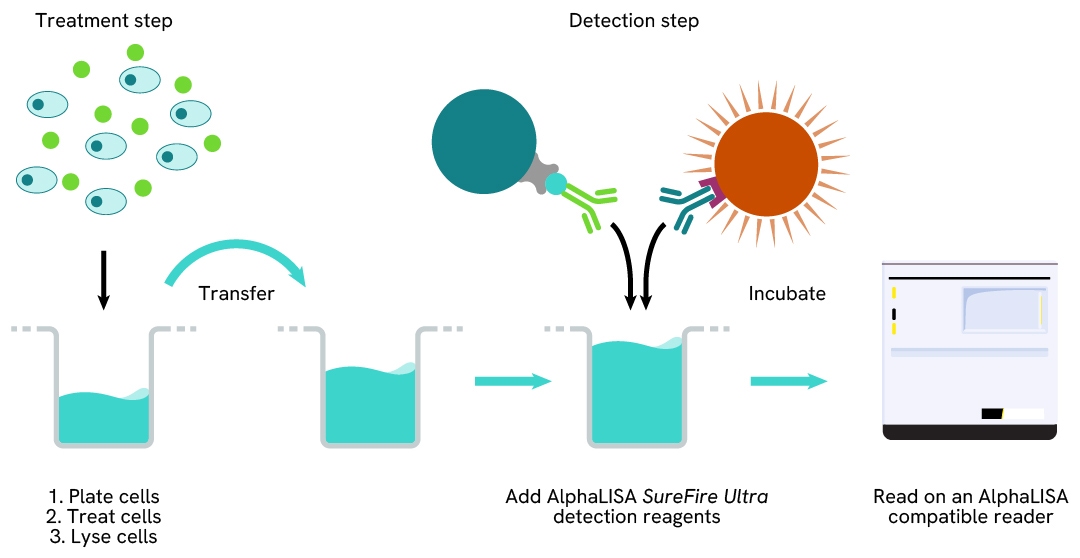
Total-AlphaLISA SureFire Ultra one-plate assay protocol
Detection of Total target protein with AlphaLISA SureFire Ultra reagents can be performed in a single plate used for culturing, treatment, and lysis. No washing steps are required. This HTS designed protocol allows for miniaturization while maintaining AlphaLISA SureFire Ultra quality.
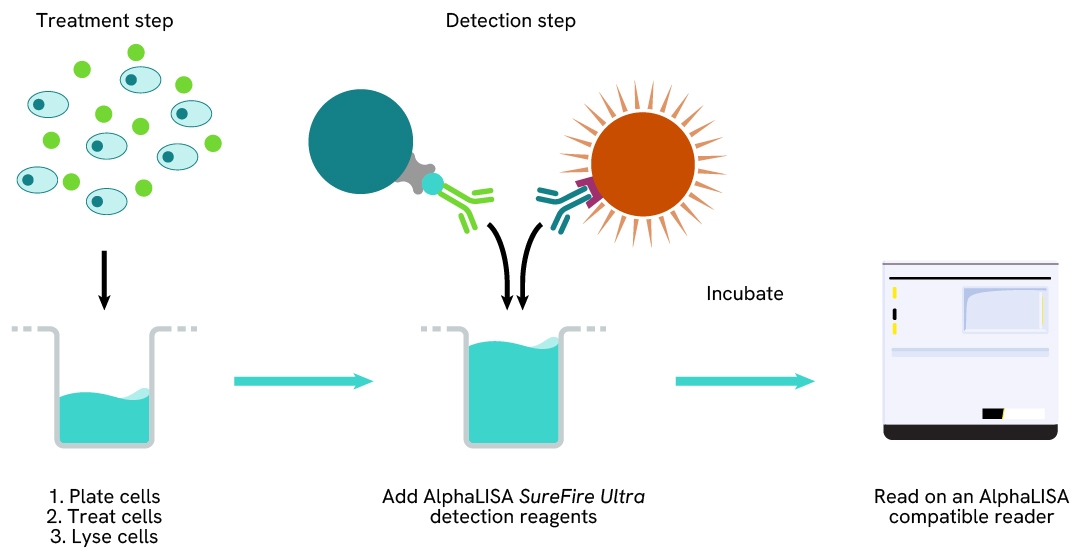
Assay validation
Activation of Total NFκB2 p100/p52 in TNFα treated cells
HeLa cells were seeded in a 96-well culture-treated plate (40,000 cells/well) in complete medium, and incubated overnight at 37°C, 5% CO2. The cells were treated with increasing concentrations of TNFα for 18 hours.
After treatment, the cells were lysed with 100 µL of Lysis Buffer for 10 minutes at RT with shaking (350 rpm). NFκB2 p100/p52 Total and NFκB p65 Total levels were evaluated using respective AlphaLISA SureFire Ultra assays. For the detection step, 10 µL of cell lysate (approximately 4,000 cells) were transferred into a 384-well white OptiPlate, followed by 5 µL of Acceptor mix and incubated for 1 hour at RT. Finally, 5 µL of Donor mix was then added to each well and incubated for 1 hour at RT in the dark. The plate was read on an Envision using standard AlphaLISA settings.
As expected, TNFα triggered a dose-dependent increase in the levels of Total NFκB2 p100/p52 while Total NFκB p65 levels remained unchanged.
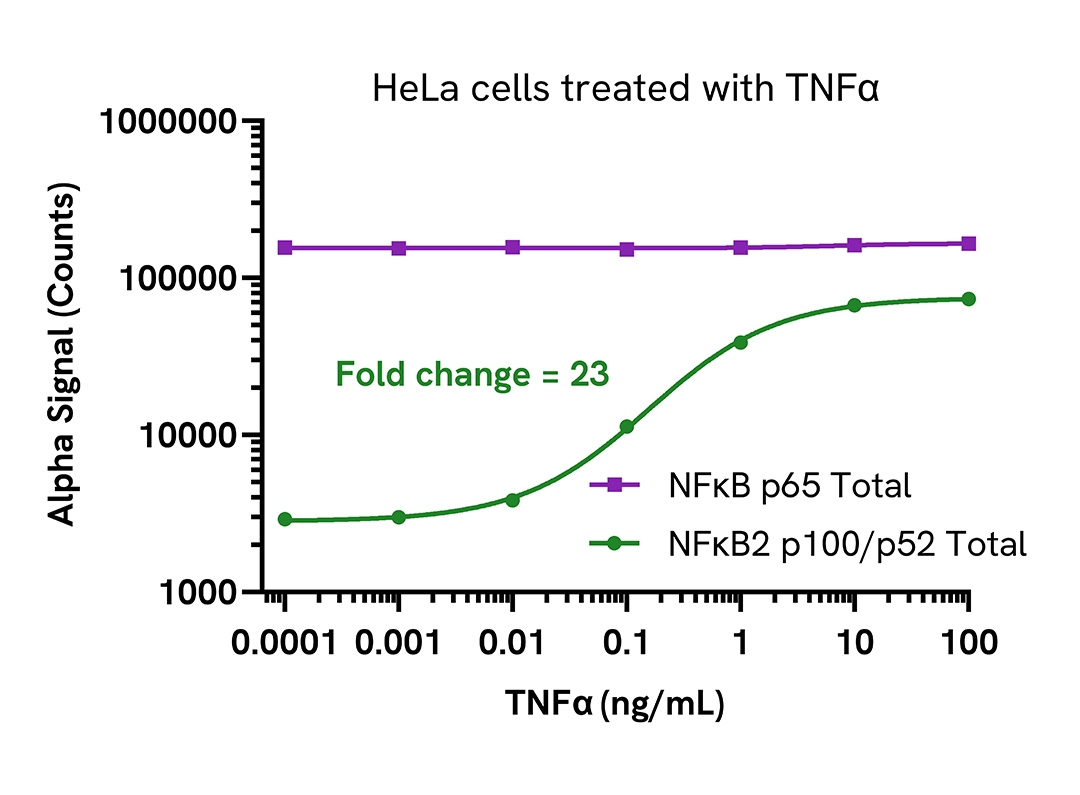
Validation of Total NFκB2 p100/p52 in LIGHT treated cells
RT4 cells were seeded in a 96-well culture-treated plate (40,000 cells/well) in complete medium, and incubated overnight at 37°C, 5% CO2. The cells were treated with increasing concentrations of LIGHT for 24 hours.
After treatment, the cells were lysed with 100 µL of Lysis Buffer for 10 minutes at RT with shaking (350 rpm). NFκB2 p100 Total, NFκB2 p100/p52 Total, and TRAF3 Total levels were evaluated using respective AlphaLISA SureFire Ultra assays. For the detection step, 10 µL of cell lysate (approximately 4,000 cells) were transferred into a 384-well white OptiPlate, followed by 5 µL of Acceptor mix and incubated for 1 hour at RT. Finally, 5 µL of Donor mix was then added to each well and incubated for 1 hour at RT in the dark. The plate was read on an Envision using standard AlphaLISA settings.
As expected, LIGHT, a NFκB non-canonical pathway activator, triggered a dose-dependent decrease in the levels of Total TRAF3 which led to a decrease in Total NFκB2 p100 and Total NFκB2 p100/p52.
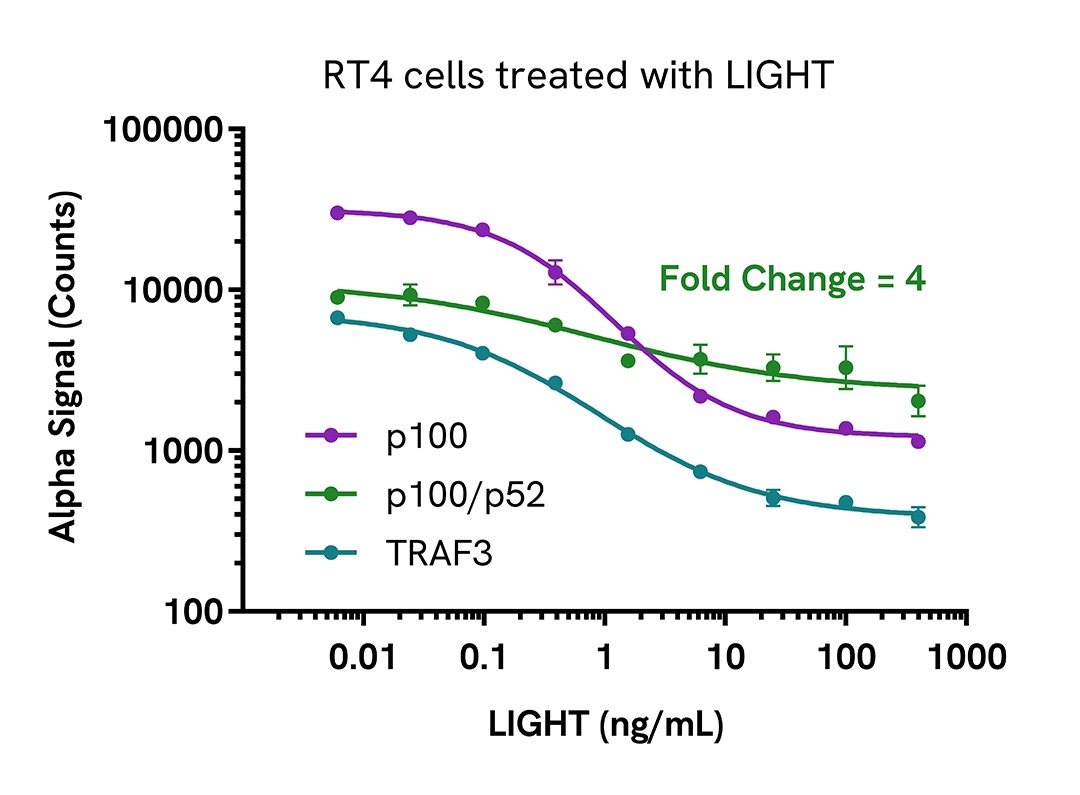
Validation of Total NFκB2 p100/p52 in LIGHT treated cells
The ratio of Total NFκB2 p100 to Total NFκB2 p100/p52 following treatment with 400 ng/mL of LIGHT for 24 hours is indicated.
As expected, LIGHT increased processing of Total p100 into Total p52, leading to a decrease in the levels of Total p100, which is demonstrated by the lower ratio observed in LIGHT treated RT4 cells.
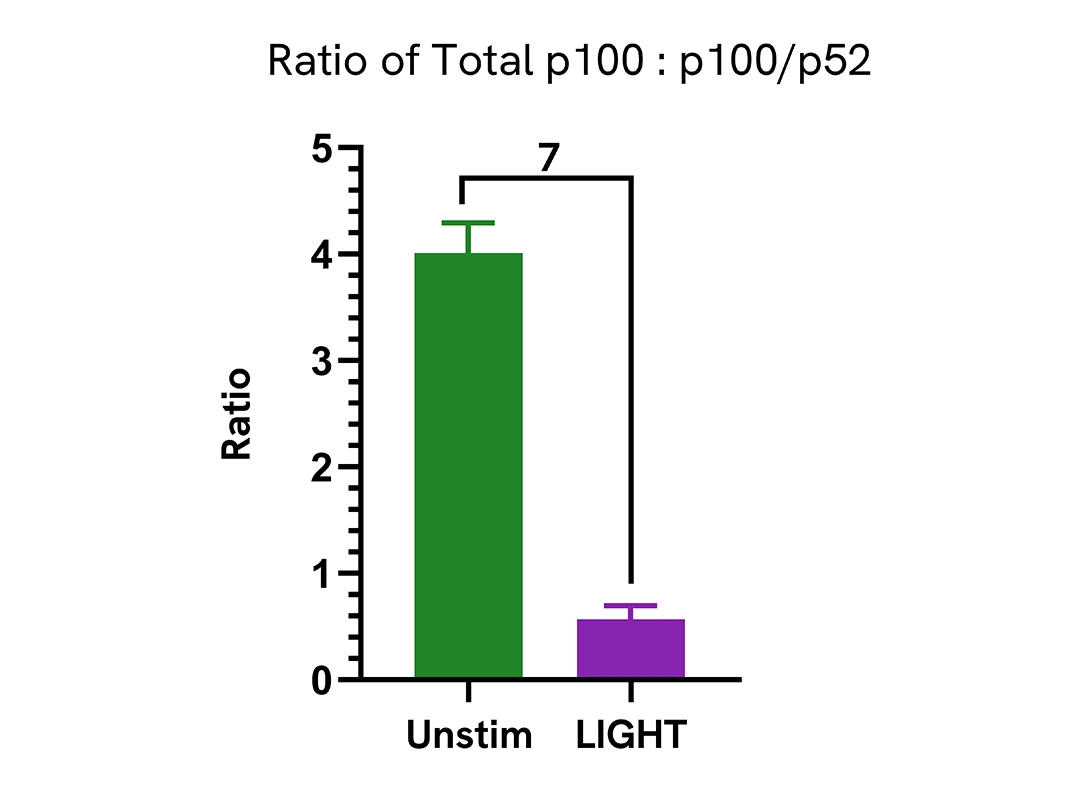
Assay specificity/selectivity
Specificity of Total NFκB2 p100/p52 assay
Total NFκB2 p100/p52 protein levels were assessed in HCT 116 wild type (WT) and HCT 116 NFκB2 p100 knockout (KO) (Abcam ab266883) cells. Both WT and KO cells were seeded in a 96-well plate (40,000 cells/well) and incubated overnight at 37°C, 5% CO2.
After treatment, the cells were lysed with 100 µL of Lysis Buffer for 10 minutes at RT with shaking (350 rpm). NFκB2 p100/p52 Total levels were then evaluated by AlphaLISA SureFire Ultra. For the detection step, 10 µL of cell lysate (approximately 4,000 cells) was transferred into a 384-well white OptiPlate, followed by 5 µL of Acceptor mix and incubated for 1 hour at RT. Finally, 5 µL of Donor mix was then added to each well and incubated for 1 hour at RT in the dark. The plate was read on an Envision using standard AlphaLISA settings.
As expected, Total NFκB2 p100/p52 was only detected in the WT HCT 116 cells but not in the HCT 116 NFκB2 p100 KO cell line, demonstrating assay specificity.
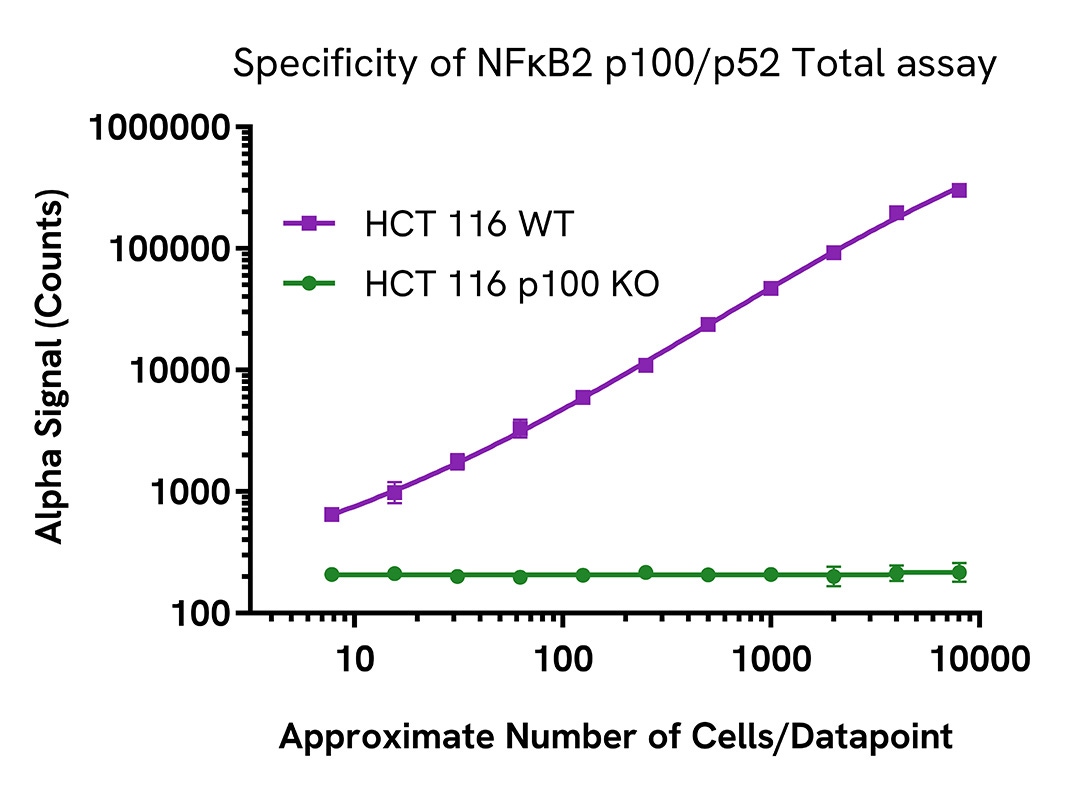
Assay versatility
Differential expression of NFκB2 p100/p52 Total assay in various cell lines
Various human and mouse adherent cells were seeded at 40,000 cells/well in a 96-well culture plate in complete medium and incubated overnight at 37°C, 5% CO2. The cells were lysed the following day with 100 µL of Lysis Buffer.
NFκB2 p100/p52 Total levels were evaluated using the AlphaLISA SureFire Ultra assay. For the detection step, 10 µL (approximately 4,000 cells) of cell lysate were transferred into a 384-well white OptiPlate, followed by 5 µL of Acceptor Mix and incubated for 1 hour at RT. Finally, 5 µL of Donor Mix was then added to each well and incubated for 1 hour at RT in the dark. The plate was read on an Envision using standard AlphaLISA settings.
Total NFκB2 p100/p52 expression was detected across all human and mouse adherent cell lines tested. A very high level of expression was detected in SW 1573 and NIH/3T3 cells, with lower levels of expression across HEK293T, A431, HeLa, RAW 264.7, SH-SY5Y and HEK293 cells, demonstrating Total NFκB2 p100/p52 assay versatility.
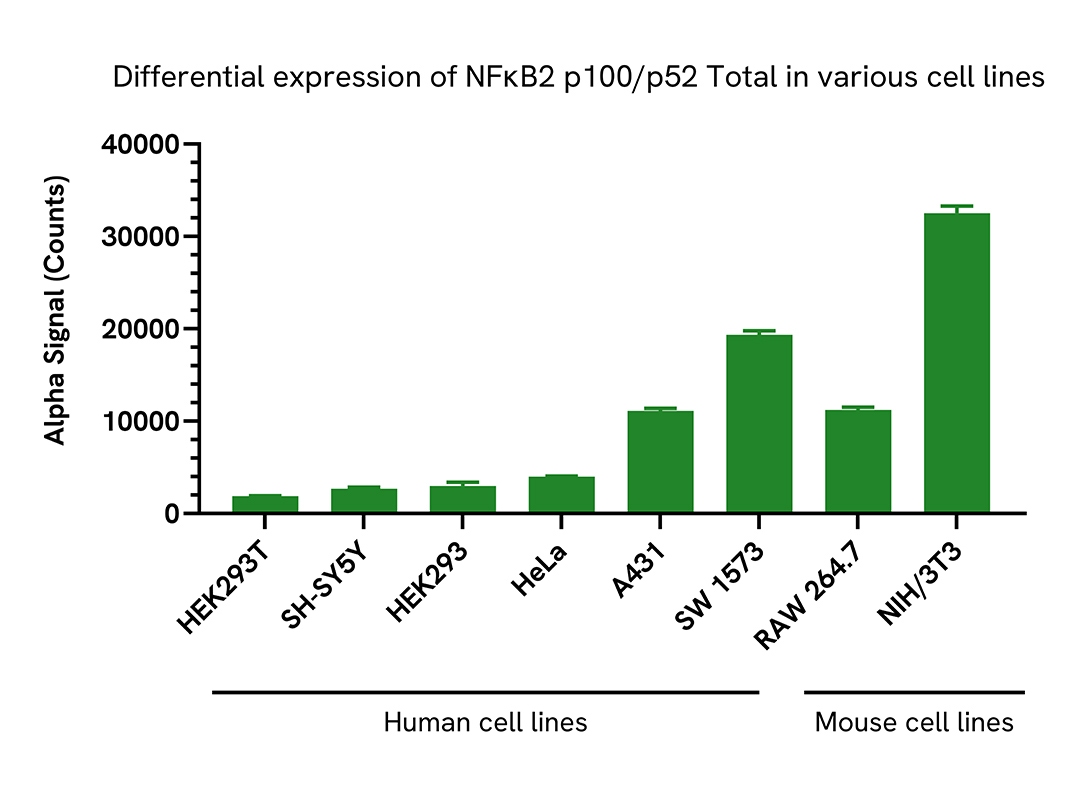
Resources
Are you looking for resources, click on the resource type to explore further.


How can we help you?
We are here to answer your questions.






























